Article
Skin - Integumentary System
The integumentary system (integument, a covering) consists of the skin (cutis) and its appendages. The protective covering for the body known as the skin is one of the largest organs of the body and accounts for approximately 16% of the body weight. It contains glands, blood vessels, lymphatic vessels, nerves, and smooth muscle (arrector pili muscles). The appendages are derived from the overlying epidermis and include two types of sweat glands, sebaceous glands, hair, and nails.
The skin has two defining tissue types, epidermis (keratinocytes are derived from ectoderm) and dermis (derived from mesoderm). The dermis interfaces with the underlying hypodermis, which is the fatty subcutaneous connective tissue or the superficial fascia of gross anatomy. Although the hypodermis not officially considered to be one of the layers of the skin, it is a loose connective tissues that attaches the skin to underlying tissues by way of vertical septae and permits skin mobility over most parts of the body (e.g., when it is pinched up), it serves as an insulator and shock absorber and serves as a caloric reservoir.
Skin is often classified as either thick skin or thin skin. This classification refers to epidermal thickness rather than dermal thickness or to the thickness of the skin as a whole. Thick skin (= thick epidermis) is restricted to palms and soles. Thin skin (= thin epidermis) covers the remainder of the body. Although skin may have a very thick dermis in some sites, as on the back, it is classified as thin skin if the epidermis is thin.
Skin has many functions, some of which can be appreciated from the study of its microscopic structure. As the covering of the body, the skin provides some protection from injury, and from the entry of microorganisms. Protection is also provided by the melanocytes, which produce pigment to shield the body from too much ultraviolet light. The skin functions in temperature regulation, e.g., by sweating, varying peripheral blood flow. It covers the surface with sebum to lubricate the epidermal surface and prevent cracking. The adipose tissue of the hypodermis provides insulation. The skin also functions in excretion (and secretion) via its sweat and sebaceous glands. Moreover, it stores fat, manufactures vitamin D and is the first guard of the immunosurveillance system. Cutaneous receptors for touch, pressure, heat, and pain stimuli provide a sensory appreciation of the environment; thus the skin serves as a sensory organ. The skin acts as a friction surface for motor tasks involving grasping, rubbing, scratching, etc. The skin is also important in preventing the loss of body fluids, a fact that is well illustrated when excessive fluid loss occurs after extensive burns.
Thick Epidermis/Thick Skin
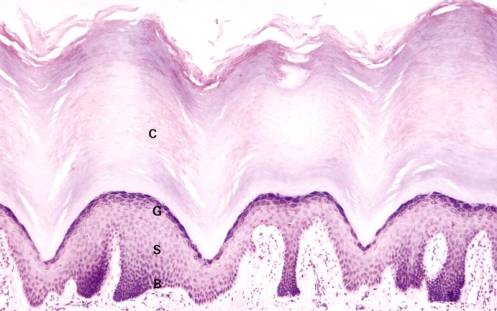
The predominant cell type, an epidermal keratinocyte begins its life cycle in the basal layer and becomes progressively more differentiated as it moves toward the surface - a process that produces a stratified squamous keratinizing epithelium.
Observe the flattened, dead surface cells (sometimes called corneocytes or dandruff in the scalp) of the thick stratum corneum. A few of the surface cells are being desquamated. Some areas of the stratum corneum show spiraling sweat ducts, each of which will end in a sweat pore at the surface. Nuclei and other cellular organelles are absent in the stratum corneum.
The stratum granulosum is composed of increasingly flattened rectangular-shaped cells filled with keratohyalin granules. The large accumulation of basophilic granules in these cells is composed of filaggrin and keratin filaments. The thickness of this layer varies from one to three cells and as a rule is representative of the rate of keratinization. Thus, there are little or no stratum granulosum or keratohyalin granules in diseases, with a rapid rate of keratinization such as psoriasis, whereas the granular layer is thickened in diseases with a slow rate of keratinization.
The stratum spinosum is composed of several layers of polyhedral cells, which flatten as the stratum granulosum is approached. See Figure left. The cytoplasm is rich in tonofibrils, which are specific for keratin pairs 1 and 10. Individual cells appear to be separated by spaces that are traversed by the so-called intercellular bridges which, under oil immersion, can be seen as fine lines between adjacent cells. 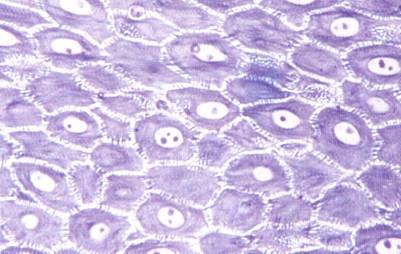
They account for the prickly appearance of the cells and for their frequent designation as prickle cells. These are tissue preparation artifacts caused when water is removed during the dehydration step. Spinous cells are attached to their neighbors by a multitude of desmosomal attachments and these connections remain as the fragile cytoplasm shrinks.
The stratum basalis is composed of a single layer of cuboidal to columnar cells, which are attached to the basement membrane by hemidesmosomes. These cells express keratin intermediate filament pairs 5 and 14. This layer contains the stem cell population and an occasional mitotic figure of a transient amplifying cell may be observed. A few melanocytes (1 for every 36 keratinocytes) can be identified by their pale (empty) cytoplasm and dark nuclei among the keratinocytes of the stratum basalis. These cells do not contain tough keratin filaments and also shrink during tissue preparation.
A basement membrane exists between the epidermis and dermis. Reticular fibers are present in the basement membrane and account for the prominence of this structure after PAS staining. Note that the border between the epidermis and dermis known as the dermal-epidermal junction is irregular because numerous upward interdigitations known as dermal papillae indent the undersurface of the epidermis. Papillae are far more prominent in thick skin than in thin skin since they serve to help these surfaces resist shear forces and friction. Rete pegs are corresponding elongated downward projecting ridges of epidermis. Some rete pegs are narrower than others are and they are the ones, which receive the sweat ducts. Under oil immersion, note that the basal cells of the larger pegs have very fine processes, which anchor the cells to the basement membrane. Basal cells of the narrow ridges are smoother, allowing them to shift more easily.
Numerous capillaries are present in the papillae of the papillary layer. Meissner's corpuscles (encapsulated sensory nerve endings for touch that resemble sectioned pinecones) can be seen in some papillae (see Figure below). The reticular layer of the dermis is so named because of the woven arrangement of the heavily cross-linked collagenous fibers (in the form of a close meshed net) and not because of the presence of reticular fibers. Note that the collagenous fibers, although cut in transverse, oblique, and longitudinal planes, run parallel and not vertical to the epidermis.
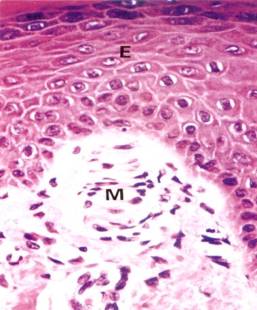
Secretory portions of eccrine sweat glands can be seen deep in the reticular dermis and extending deeper into the upper hypodermis. In addition to the secretory portions of sweat glands, the hypodermis (subcutaneous connective tissue) contains lobules of adipose tissue, which are separated by strands of collagenous fibers. When these septae become excessively filled with well-nourished adipocytes, the surface of the skin becomes dimpled and the appearance is known as cellulite.
Thin skin
The epidermis of thin skin has far fewer cells in each of its layers (i.e., the total thickness of the stratum corneum, stratum granulosum, and stratum spinosum are greatly reduced in thickness). Identify the melanocytes with dark nuclei and pale cytoplasm that can be seen interspersed between the keratinocytes in the stratum basale. Note that the brown melanin pigment that is present is confined to the keratinocytes in either the basal epidermis or those in the hair bulb. A few pigment containing macrophages can occasionally be seen in the dermis. These cells are phagocytic and do not produce pigment. Note that the dermal papillae and rete pegs are less developed than in thick skin thus the waviness of the dermal-epidermal junction is not as pronounced. The dermis is comparable to that of thick skin in that it has a thinner, more superficial papillary layer and a thicker, more deeply situated reticular layer.
The small blood vessels of the subpapillary plexus are located at the junction of the reticular layer and the papillary layer. Vessels arising from this plexus can be seen as capillaries and arterioles in the dermal papillae. The papillary blood vessels are in close association with the epidermal cells, which require nourishment for their growth and development.
Melanin, the pigment largely responsible for skin color, is produced by melanocytes, which number about the same in all races but differ in the amount of melanin they produce. Melanin is transferred via long cytoplasmic processes of melanocytes to the intercellular spaces where it is taken up by keratinocytes and placed in a supranuclear position melanosomes. Cell bodies and cytoplasmic processes of melanocytes are not clearly shown by conventional stains, but they can be demonstrated by treatment of sections with dihydroxyphenylalanine (DOPA). The DOPA reaction demonstrates that the cell bodies of most melanocytes are located in the stratum basale while their cytoplasmic processes (some times called dendritic processes) extend between cells of the stratum spinosum. Cells from the melanocytic lineage can also be identified by immunostaining using an S-100 antisera.
Epidermal Appendages/Adnexal Structures
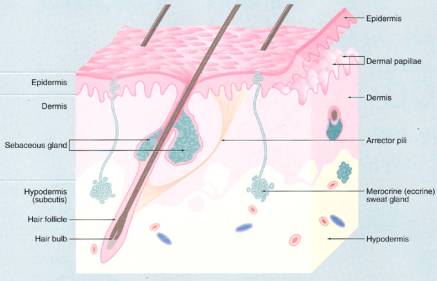
The small, cuboidal cells -bordering the basement membrane undergo mitosis to replenish the more central ones which accumulate lipid and are lost as the glandular secretion. As a cell accumulates fat droplets, it enlarges to become polyhedral or spherical in shape. The nucleus becomes pyknotic and the entire cell eventually disintegrates to enter the sebaceous gland duct as sebum. This mode of secretion in which the entire cell is lost is called holocrine secretion, and is characteristic of sebaceous glands. Find a duct, which connects with the alveoli of a sebaceous gland. Ducts are lined with stratified squamous epithelium and open into hair follicles. Sebaceous glands in some locations (e.g., those in the margins of the lips, nipple, and glans and prepuce of penis) do not connect with hair follicles, but directly onto the surface of the skin.
There are two classes of sweat glands (sudoriparous glands), merocrine and apocrine. Most sweat glands of the body are of the merocrine type and are usually referred to as eccrine sweat glands. They are most numerous in the skin of the palms, soles, and forehead. It has been estimated that they number about 3000 per square inch in the palm of the hand. They are called merocrine glands because they secrete by the merocrine method, i.e., no part of the cell is lost with the secretion. Secretion leaves the cells in a manner that might be described as reverse pinocytosis. Apocrine sweat glands are encountered in only a few areas, e.g., in the axillae and in the anogenital region. They are called apocrine glands because they secrete by the apocrine method, i.e., the apical portion of the cell breaks off to form part of the secretion. Both types of sweat glands are simple coiled tubular glands. This means that each sweat gland has its own duct (one duct per gland) and that the secretory portion of the gland is a small-coiled tube.
Secretory portions of the glands lie deep in the dermis, at the dermal-hypodermal junction, or occasionally within the hypodermis. A section through the secretory portion of a sweat gland will cut the coiled tubule into several cross sections (see Figure left photo). It may appear that two layers of secretory cells line a tubule, but the outermost cells with somewhat elongated nuclei are the myoepithelial cells, which occupy a constant position between the basement membrane and the base of the secretory cells (see Figure right photo). Myoepithelial cells have long contractile processes, which embrace the secretory cells and squeeze out the secretion. The processes are not visible in H&E preparation, but they can be demonstrated by the alkaline phosphatase technique. Myoepithelial cells are also present in other glands, salivary glands, and mammary glands, and in each instance they occupy a similar position between the basement membrane and the base of the glandular epithelial cell. In addition to basally located myoepithelial cells, pale cuboidal secretory cells can be seen surrounding the lumen of the secretory tubule.
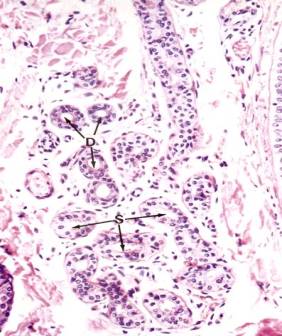
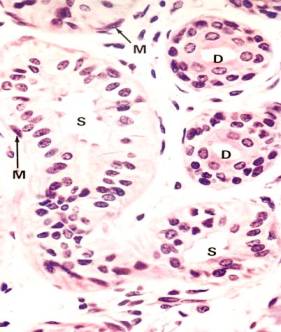
Intradermal sweat ducts are lined by two layers of cells whose cytoplasm is darker than that of secretory cells. The two-layered epithelium of the sweat duct is classified as stratified cuboidal. Myoepithelial cells are absent in the duct.
Secretory portions of apocrine glands are much larger than secretory portions of eccrine glands and their lumina measure as much as 200 μm in diameter (see Figure 61 below). This is ten times the average diameter of lumina of eccrine sweat glands. Apices of some cells of apocrine glands are rounded and can be seen breaking off to enter the lumina as part of the secretion. This mode of secretion where part of the cell is lost is termed apocrine secretion. Myoepithelial cells are present in secretory portions of apocrine glands, and appear even more prominent than in eccrine glands.
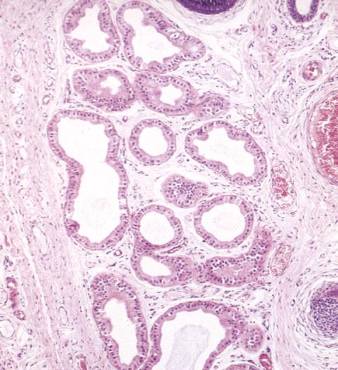 Micrograph of apocrine sweat glands.
Micrograph of apocrine sweat glands.
The intradermal ducts of apocrine glands have the same histological appearance as corresponding ducts of eccrine glands. They are devoid of myoepithelium and have a double layer of dark staining epithelial cells, which have a periluminal cuticle. The latter becomes especially prominent as the duct traverses the papillary layer of the dermis. Most ducts of apocrine glands open into hair follicles, but some open directly onto the surface, as do all eccrine ducts. Quite commonly, more than one apocrine duct empties into the same hair follicle, usually entering the follicle slightly above the opening of the sebaceous duct.
Apocrine and eccrine glands have other differences in addition to those of histological importance. Eccrine glands are supplied with cholinergic fibers while apocrine glands are supplied with adrenergic fibers. Eccrine glands serve primarily in heat regulation whereas apocrine glands represent scent glands similar to those producing pheromones in lower animals. Both types of glands are stimulated to secrete by stresses such as fright and pain, but eccrine glands also respond to heat while apocrine glands do not. In contrast to eccrine glands, apocrine glands are greatly influenced by hormones, becoming active about the time of puberty and showing secretory variation during the menstrual cycle.
Hair Follicles/Nails
Keratinocytes that form these appendages grow downward from the surface during the 3-4 month of development. The stem cell population resides in the bulge region where the erector pili muscle inserts into the hair shaft. Periodically these cells grow downward (anagen growth phase), form an expanded hair bulb in the deep dermis or hypodermis and begin to undergo a special pattern of differentiation that will produce a highly keratinized structure known as hair. The transiently amplifying hair matrix cells are found at the upper indentation of the hair bulb above of a tuft of capillaries, the dermal hair papilla that provide nourishment. Melanocytes also populate the hair bulb region and provide coloration to the hair. The cells lining the outer surface of the length of the hair follicle are known as outer root sheath cells and the multiple inner cell layers are known as inner root sheath cells.
Hairs (terminally differentiated cells that are equivalent to dead stratum corneum squames on the surface) move upward where they become coated with sebum (oil) and eventually erupt at the epidermal surface. Hair (totally dead cells) has an outer cuticle and an inner cortex. Periodically the hair bulb begins to regress upward to the bulge region (catagen phase), the hair is shed at the surface, and the hair follicle enters the telogen (resting) phase. The length of the hair growth cycle and the type of hair (terminal hair on the head, vellus-fine hair, pubic hair) is determined by local signals as well as hormones.
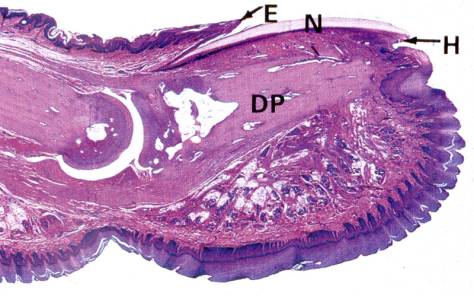 Micrograph of a developing fingernail on the distal phalanx (DP). E = eponychium, N = Nail, H = hyponychium.
Micrograph of a developing fingernail on the distal phalanx (DP). E = eponychium, N = Nail, H = hyponychium.
Fingernails and toe nails represent yet another type of differentiation (see Figure). The nail matrix cells are located under the skin fold at the proximal region of the distal phalanx. Destruction of nail matrix cells will result in a permanent nail loss. The more differentiated cells advance toward the fingertip. The newly differentiated cells form a crescent-shaped lunula (white region that is grossly visible). The proximal dead skin that is carried forward by continuous nail growth is known as the eponychium and the fold of skin underneath the distal growing tip is called the hyponychium. The dead nail advances across epidermal cells called the nail bed.
Prostate Cancer
About Prostate Cancer

Prostate cancer is a form of cancer that develops in the prostate, a gland in the male reproductive system. The cancer cells may metastasize (spread) from the prostate to other parts of the body, particularly the bones and lymph nodes. Prostate cancer may cause pain, difficulty in urinating, problems during sexual intercourse, or erectile dysfunction. Other symptoms can potentially develop during later stages of the disease.
Causes
The specific causes of prostate cancer remain unknown. A man's risk of developing prostate cancer is related to his age, genetics, race, diet, lifestyle, medications, and other factors.
The primary risk factor is age. Prostate cancer is uncommon in men younger than 45, but becomes more common with advancing age. The average age at the time of diagnosis is 70. However, many men never know they have prostate cancer. Autopsy studies of Chinese, German, Israeli, Jamaican, Swedish, and Ugandan men who died of other causes have found prostate cancer in thirty percent of men in their 50s, and in eighty percent of men in their 70s. In the year 2005 in the United States, there were an estimated 230,000 new cases of prostate cancer and 30,000 deaths due to prostate cancer.
Swine flu vaccines
September 25, 2009
The first five million swine flu vaccine dosages will be available to Australians next week but children under 10 will have to wait until at least October.
Experiments are underway at the Melbourne based manufacturer CSL to ensure the vaccine is safe in children.
The paediatric vaccine is supposed to be available sometime in October, after trials are completed and approved by the Therapeutic Goods Association.
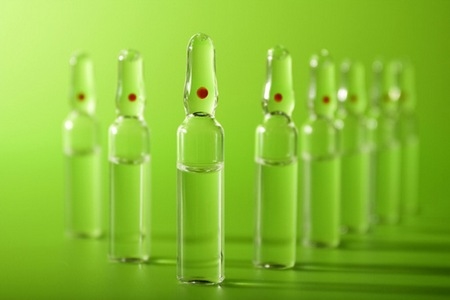
Federal Health Minister Nicola Roxon, who toured CSL's laboratories on Thursday, urged Australians to contact their GPs from September 30 to access the vaccine.
'We are urging all Australians particularly who are aged 10 and over to consider being vaccinated,' she told reporters.
'We expect to get 21 million doses of the vaccine provided by January next year,' she said.
Common Remedies
It is quite clear that the forms taken by various commonly occurring illness and the appropriate remedies will vary according to wether you have vata, pitta or kapha dosha. The following sections therefore aim to give you individually a plan of action, setting out all the do’s and do not’s. Note that in the case of any persistent, or indeed serious illness, you must immediately contact a qualifies professional expert.
lnsomnia
Any vata-increasing influence can contribute to your insomnia, including regular travel, stress, an irregular lifestyle, and the excessive use of stimulants such as tea and coffee. The herbs used to treat vata-based insomnia are brahmi (Centella), jatamansi, ashwagandha (Withania somnifera) and nutmeg. Any good massage using brahmi oil will also produce considerable, quickly noticed benefits.
Insomnia in the pitta dosha is brought on by anger; jealousy, frustration, fever; excess sun or heat. Follow the pitta plan, which is cooling, and take brahmi, jatamansi, bhringaraj (Eclipta alba), shatavari and aloe vera juice. Massage brahmi oil into the head and feet. Again, this is marvellously refreshing.
As kapha types like to sleep and tend to be rather sleepy and sluggish, they rarely suffer from attacks of insomnia.
Headache/Migraine
Vata headaches cause extreme pain and are related to anxiety and tension. Relevant treatments include triphala to clear any congestion, jatamansi, brahmi and calamus.
Pitta headaches are associated with heat or burning sensations, flushed skin and a visual sensitivity to light. They are related to anger; frustration or irritability, and will be connected to the liver and gall bladder. Treatments are brahmi, turmeric and aloe vera juice. Kapha headaches are dulr and heavy and can cause nausea. There may also be congestion, such as catarrh. Have a stimulating massage with minimal oil
Colds
A tendency to mucus production or catarrh/phlegm is unpleasant for the sufferer; and is usually the result of poor digestion of foods in the stomach which increases ama (toxicity) and kapha. In general, kapha is generally considered the most highly effective dosha.
Vata-type colds involve dry symptoms, such as a dry cough or dry throat. Herbs for vata coughs and colds are ginger; cumin, pippali, tulsi (holy basil, Ocimum sanctum), cloves and peppermint, licorice (not to be used with high blood pressure or oedema), shatavari and ashwagandha. Put one or two drops of sesame oil up each nostril, and then follow the vata plan until all the symptoms are seen to subside.
Pitta-type colds involve more heat, the face is usually red and there may even be a fever. The mucus is often yellow and can actually contain traces of blood. Herbs for tackling pitta coughs and colds include peppermint and various other mints, sandalwood, chrysanthemum and small quantities of tulsi (holy basil).
Kapha colds are thick and mucusy with a feeling of heaviness in the head or body. Avoid cold, damp weather and exposure to cold and damp conditions. Eliminate sugar, refined foods, meat and nuts dairy products. Bread, fats and oils from the diet and use plenty of hot spices. Drink a spiced tea of hot lemon, ginger and cinnamon with cloves or tulsi, sweetened with a little raw honey. Herbs for kapha colds are ginger, cinnamon, pippali, tulsi (holy basil), cloves and peppermint. Saunas and hot baths will help to increase the heat of the kapha person but they should not be used in excess as this would actually increase the pitta too much. Follow the kapha plan until the symptoms subside.
Skin Problems
These are often caused by internal conditions taxicity (ama) and are mainly related to the pitta dosha. Vata skin problems will be dry and rough. Avoid letting the skin dry out. Herbal remedies for vata skin are triphala and satisabgol. Pitta skin problems will be red and swollen, often with a yellow head, Avoid sun heat or hot baths, and increase your intake of salads. Follow the pitta plan and add turmeric, coriander and saffron to your diet. The remedies are manjishta (Rubia cordifolia), kutki (Picrohiza kurroa), turmeric anc aloe vera juice. Kapha skin problems involve blood congesion which can cause the skin to form thick and mucusy whiteheads. Increase your level of exercise, and follow the kapha’s plan. Treatments should always include a small amount of calamus with some dry ginger and quantities of turmeric.
Urinary lnfections
Excess cold water, tea, coffee, and alcoholic drinks will weaken the kidneys, Salt, sugar or foods that are rich in calcium, such as dairy products or spinach, will similarly tend to weaken and toxify the kidneys. The best kidney tonic to use in Ayurveda is shilajit, a mineral-rich compound from the Himalayan mountains, but avoid it if you suffer from kidney stones. Pregnant women, children or those on medication should consult an Ayurvedic practitioner before treatment.
Coughs
Vata coughs are fry and irritated with very little mucus, the chief symptom being a painful cough often accompanied by adry mouth. Herbs and spices for the vata cough include licorice (do not use this if you have high blood pressure or oedema), shatavari, ashwagandha and cardamom. Follow the vata plan until the symptoms subside.
Pitta coughs are usually associated with a lot of phlegm. The chest is congested and very uncomfortable but the mucus cannot be brought up properly. There is often fever or heat combined with a burning sensation in the chest or throat. High fevers should be treated bya physician and people suffering with asthma should consult their doctor immediately if a cough or cold leads to wheezing and difficult breathing. The best herbs for pitta coughs include peppermint, tulsi (holy basil) and sandalwood. Follow the pitta plan until the symptoms have completely subsided.
With Kapha coughs the patient usually brings up lots of phlegm and suffers a loss of appetite combined with nausea. The chest is loaded with mucus, but this may not be coughed up because the kapha individual is likely to feel tired. Treatments for kapha coughs are raw honey, lemon, cloves and chyawanprash (a herbal jam). Follow the kapha plan until the symptoms subside, increasing your intake of hot spices and do try to use trikatu powder. Also Keep warm.
Cystitis
In vata people, cystitis will tend to be less intense. Remedies are shilajit (to be avoided if you suffer from kidney stones) with bala (Sida cordifolia), ashwagandha and shatavari,
Cystitis is mainly a pitta condition because it burns and is hot.
Follow the pitta plan, using plenty of coriander (cilantro) and avoiding hot spices. Remedies include aloe vera juice (not to be used in pregnancy), lime juice, coconut and sandalwood. Kaphatype cystitis is accompanied by congestion and mucus in the urinary tract. The treatments are cinnamon, trikatu combined with shilajit, gokshura and gokshurdi guggul.
Kapha People's Dietary Tips
Kapha people should focus upon cooked food, but can have some salads occasionally
They should avoid fats and oils unless they are hot and spicy Dairy products, sweet, sour and salty tastes and a high intake of wheat will also aggravate kapha.
Although some meats and animal products have been included, they should always be used in moderation.
To reduce any excess levels of kapha (vikruti), or to maintain the right balance because you are a kapha dosha (prakruti), include the following items in your eating plan and try to avoid any foods that are not listed here.
Herbs and Spices
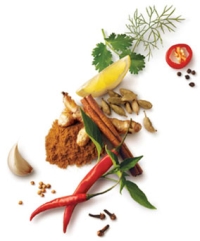
Asafoetida (hing), black or Indian pepper; chilli pepper; coriander leaves (cilantro), dry ginger; garlic, horseradish, mint leaves, mustard, parsley or any other hot spices,
Grains and Seeds
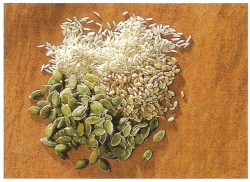
Barley, buckwheat, corn, couscous, oat bran, polenta, popcorn (plain), rye, sprouted
wheat bread, toasted pumpkin seeds and occasional small quantities of toasted sunflower seeds.
Beans and Pulses

Barley, buckwheat, corn, couscous, oat bran, polenta, popcorn (plain), rye, sprouted
wheat bread, toasted pumpkin seeds and occasional small quantities of toasted sunflower seeds.
Vegetables

Artichokes, broccoli, Brussels sprouts, cabbage, carrots, cauliflower; celery, daikon radish, fennel, green beans, kale, leeks,
lettuce, mushrooms, okra, onions, peas, peppers, radishes, spinach, Kapha vegetables should be cooked.
Fruits

Apples, apricots, berries, cherries,peaches, pears, pomegranates and prunes.
Cooking Oils

Corn, almond or sunflower oil may be used in small quantities.
Drinks
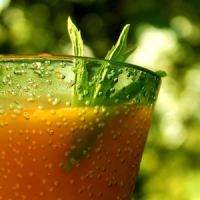
Fruit drinks should not contain sugar or additives. Recommended hot drinks include black tea, carrot juice, cranberry juice, grape juice, mango juice, mixed vegetable juice, nettle tea, passion flower tea, raspberry tea and occasional wine
Click Here for information about Vata People's Dietary Guide
http://www.byhealth.com/deitary-tips
Click Here for information about Pitta People's Dietary Guide
http://www.byhealth.com/dietary-tips
Pitta
Pitta people are generally quite well-balanced, well-proportioned, rounded, admired by all, but they can suddenly become passionately focused and intense. At its most extreme this tendency leads to a high degree of intolerance and irritability. Consequently pitta types should keep well away from any foods that are known to be hot and spicy, and which might inflame them, and concentrate on meals inflame them and concentrate on meals that promote their more soothing side.
Elements : fire and water.
Climate : hot and moist.
Principle : transformation. Em 0 t ion s: hate, anger, resen intolerance, impatience, irritability. indignation, jealousy, good humour, intelligence, alertness, open warm-heartedness.
Systems most affected by excess pitta : skin, metabolism. small intestines, eyes, liver, hair on
the head.
Symptoms of excess pitta: skin disorders, acidity, sun-sensitivity, premature degrees of hair loss or loss hair colour, outbreaks of diarrhoea.
The pitta body type is usually of average build and nicely proportioned. Pittas like food and have a healthy appetite. The hair is usually straight, fine and fai~ though dark-haired people can also be pitta types. People with red hair will automatically have some level of pitta within their nature. Like the fire element, their temperament can be quite intense, and when it manifests itself in excess this can lead to marked intolerance.
Pitta skin will have a tendency to be sensitive to the sun, and pitta types will need to be very careful how much time they spend in direct sunlight. The fiery nature of the sun will sometimes inflame the pitta person, leading to skin rashes, freckles and sunburn. Cool showers, cool environments and plenty of long cooling drinks (but not ice-cold ones) will help to alleviate any high temperatures and calm down pitta types.
People of this nature can be impatient, having highly active and alert minds. However pitta people can also have a very good sense of humour and a warm personality.
Click here to find more about Pitta People's Dietary Guide
http://www.byhealth.com/pitta-peoples-dietary-tips
Vata People's Deitary Tips
Vata people must always be quite careful, but not to the point that cooking suddenly becomes something of a difficult problem.
The easy-to-follow, basic guidelines are as follows.
- You must avoid all kinds of fried foods, no matter how tempting and you should eat at regular intervals, Irregular, huge meals are to be avoided at all costs.
- To reduce any excess vata then follow the vata diet and recommendations in your eating and living plan.
- Always attempt to avoid any foods and other items that are not listed as far as it possible.
- If animal products are a part of your diet, they should be used strictly in moderation
Herbs and Spices

Almond essence, asafoetida (hing), basil leaves, bay leaves, cardamom pods, coriander (cilantro), fennel, fresh ginger, marjoram, mint, nutmeg, oregano, paprika, parsley, peppermint, spearmint, tarragon, thyme, turmeric and vanilla.
Grains and Seeds

Oats (cooked), pumpkin seeds, quinoa, rice (this includes all kinds and varieties), sesame seeds, sprouted wheat bread, sunflower seeds and wheat.
Nuts, Meat and fish
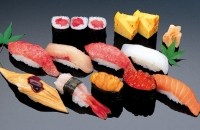
almonds, brazil nuts, cashews, hazelnuts,
macadamias, pecans, pine nuts, pistachios
walnuts. Beef, chicken, duck, eggs, sea, fish, shrimps and turkey.
Vegetables

Artichokes, asparagus, beetroot, carrots, courgettes (zucchini), cucumber, daikon radish, green beans, leeks, okra, olives, onions (cooked), parsnips, pumpkins, radishes, spinach (cooked), swede (rutabagas), sweet potatoes, tomatoes (cooked), and fresh watercress.
Fruits

Apricots, avocados, bananas, berries, cherries, fresh coconuts, dates, fresh figs, grapefruit, grapes, lemons, limes, mangoes, melons, oranges, peaches, pineapples, rhubarb and strawberries.
Dairy Products

Cow's milk, cottage cheese, goat's milk,
goat's, cheese and soft cheese - all are to
be taken sensibly, in moderation.
Cooking Oils
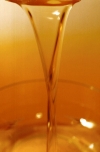
Unrefined sesame oil.
Drinks

Apricot juice, carrot juice, ginger tea, grape juice, grapefruit juice, orange juice, hot dairy drinks, lemon balm tea lemonade and peach juice
Click Here for information about Pitta People's Dietary Guide
http://www.byhealth.com/pitta-peoples-dietary-tips
Click Here for information about Kapha People's Dietary Guide
http://www.byhealth.com/kapha-peoples-dietary-tips
Vata
Vata types are known to be rather restless, cool people, who certainly notice the cold, When you have excess levels of vata, fear, depression and nervousness become quite marked significant traits, and with repressed emotions comes a definite weakening of the immune system. However by adapting the appropriate lifestyle, and making one or two changes you will create a better balance within yourself, and find that you achieve much more.
Elements : ether and air.
Climate : dry and cold.
Principle : movement.
Emotions : fearful, anxious, apprehensive, sensitive, timid, lacking confidence, slightly nervous, changeable.
Systems most affected by excess vata: the nervous system and also the colon.
Symptoms of excess vata: flatulence, back pain, problems with circulation, dry skin, outbreaks of arthritis, constipation, and
nerve disorders.
The vata body type is usually thin and narrow. Vatas do not gain weight easily and are often restless by nature, especially when they are busy and active. They have dry hair and cool skin and a tendency to feel the cold. Their levels of energy are erratic, and they have to be very careful not to exhaust themselves, leading to inconsistency. They may find it quite hard to relax, which can lead to an overactive mind and insomnia.
Vata symptoms will be changeable, being cold by nature and therefore worse in cold weather Any pain will worsen during change. Vata people can suffer from wind, low back pain, arthritis and nerve disorders because of their individual restless nature, certainly require a regular intake of nourishment, and they should sit down to eat or drink at regular times. Careful exercise should always be taken in moderation, clearly maintaining a gentle, regular; well-worked out routine that will help to keep the mind focused, and in perfect harmony with the body.
Click here to find more about Vata People's Dietary Guide
http://www.byhealth.com/vata-peoples-deitary-tips
Ayurveda and its Origin
What is Ayurveda ?
It may be little known and remarkably few people seem to have heard of it – but ayurveda is a highly respected, highly revered ancient form of learning which has an amazing amount to teach us. It brings peace of body and mind, important ways of seeing the world and your own place in the scheme of things, and highly practical, sensible ideas when it comes to medicine, dietand ways of staying calm and relaxed
The Orgins of Ayurveda
The Origins of Ayurveda are uncertain. It is recounted that thousands of years ago, men of wisdom or rishis (meaning seers) as they are known in India, were saddened by the suffering of humanityThey knew that ill health and short lives allowed man little time to consider his spirituality and to commune with the divine - with God.
In the Himalayan mountains they prayed hard and meditated together; calling upon God to help them to relieve the plight of man, and God felt moved by compassion and gave them the essential teachings that would enlighten them in the ways of healing illness,
and thereby alleviate and remove all suffering on the earth.
It is believed that these teachings are the Vedas, although this cannot be proven, due to the lack of historical records. A book called the Atharva Veda was one of the first detailed accounts of the system. From this, and perhaps other ancient writings, came
The beginnings of Ayurvedic medicine which has developed changed and absorbed many other influences over hundreds of years to become what it is today. Due to the invasions of India over the years and the subsequent suppression if many original Indian ways of life, several ancient texts have been lost or even destroyed, but enough have survived to ensure the active continuation of these highly valued greatly respected teachings.
Ayurveda is now acknowledged as the traditional healing system of India. It comes from two Sanskrit words, ayur, Meaning “life” and veda meaning “knowing” and can be interpreted as meaning the “Science of Life”. The oldest healing system to remain intact, it is very comprehensive and has influenced many healing systems around the world
For more details about Ayurvedic Body Types
Click here :
http://www.byhealth.com/body-types
